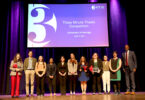Athens, Ga. – Nationwide, 34 percent of girls get pregnant at least once before age 20, according to a study for the National Campaign to Prevent Teen Pregnancy. In Georgia, 86 out of every 1,000 African-American girls age 15-19 and 58 of 1,000 white teens become pregnant. According to new research from the University of Georgia, increasing minority teachers can improve these health outcomes.
“African-American teachers drive down African-American teenage pregnancy rates,” said Vicky Wilkins, who co-authored a paper on the subject appearing in the October issue of the Journal of Public Administration Research and Theory.
Looking at Georgia public school data from 143 districts from 2002-2006, Wilkins and former graduate student Danielle Atkins compared teacher representation in high schools and teen pregnancy rates reported by district to the Georgia Department of Community Health. They found increasing the number of minority teachers decreases teen pregnancy among those populations.
“You do not see a decrease in teen pregnancy for African-American teenagers until you reach a critical mass of African-American teacher representation,” said Wilkins, who is an associate professor of public administration and policy in the UGA School of Public and International Affairs. “We identified 17.6 percent as the tipping point where the percentage of African-American teachers started to significantly lower the African-American teen pregnancy rate.”
Study findings show a 10 percent increase in African-American teachers would result in six fewer African-American teen pregnancies per district. Districts with 20 to 29 percent African-American teachers resulted in a significant decrease in teen pregnancy, 18.8 fewer pregnancies per 1,000 students.
“The number of pregnancies continues to drop as representation increases,” Wilkins said. “When there are few African-American teachers in a school, we observe no effect on African-American teen pregnancies.”
An increase in African-American teachers has no effect on teenage pregnancy rates among white students. Similarly, representation of white teachers has no effect on teenage pregnancy among white students. The results also reveal increased African-American student population, unemployment and higher white teen pregnancy rates are all associated with higher African-American pregnancy rates.
To further understand the influence of minority teacher representation, Wilkins and Atkins interviewed a convenience sample of 11 high school teachers and one school district administrator. Teachers represented several high schools, in both majority-majority and majority-minority settings. Asking about the influence teachers can have on student behaviors both inside and outside the classroom, discussions with teachers and the administrator offered insights into the influence that teachers have in educational and non-educational decisions of their students.
Interview results reveal race-match was important for role modeling with regard to non-educational outcomes.
“All of the African-American female teachers we spoke with shared example after example of both male and female African-American students asking questions about relationship choices and decisions,” Wilkins said.
Both male and female students would ask for advice on premarital sex, how to treat a girlfriend or boyfriend and about parenting. These questions often lead to frank discussions about contraception, pregnancy and risky behaviors.
“Our discussions convinced us that, although any teacher can serve as a role model, African-American students seek out role models that look like them, particularly with regard to non-educational issues,” Wilkins said.
Wilkins has done previous research looking at how minority teachers increase educational benefits for minority students.
“I think we have to consider the broad impacts of minority teacher representation. It is an important consideration for hiring and training of teachers, and we have to be aware of the role that community and culture play in discussions of risky behaviors,” Wilkins said.
The full article is available online, http://jpart.oxfordjournals.org/content/early/2013/02/14/jopart.mut001.abstract.







